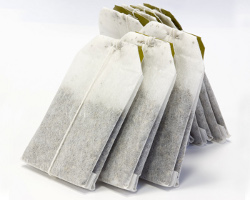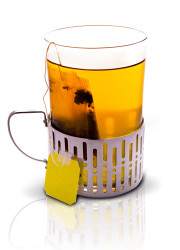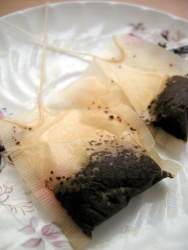Composting teabags
 Over on the Really Good Life the other day, I listed all the consumables I used in one day and their packaging. I think it’s easy to become blind to things you routinely use and listing them helped me realise where I was creating unnecessary waste/exposing myself to unnecessary synthetic chemicals in my day to day life. I’m going to do the exercise again a few times over the next couple of weeks to get a more accurate broader picture (for example, on the first day, I didn’t do any household cleaning or laundry, or much cooking).
Over on the Really Good Life the other day, I listed all the consumables I used in one day and their packaging. I think it’s easy to become blind to things you routinely use and listing them helped me realise where I was creating unnecessary waste/exposing myself to unnecessary synthetic chemicals in my day to day life. I’m going to do the exercise again a few times over the next couple of weeks to get a more accurate broader picture (for example, on the first day, I didn’t do any household cleaning or laundry, or much cooking).
The reason I’m mentioning it here is two-fold — firstly, I thought it was a useful exercise and I’d recommend it anyone wanting to reduce. Secondly, I categorised my teabags as “probably not compostable” so possibly destined for landfill, which caused a bit of discussion in the comments (we do actually compost our teabags but not without a little hesitation). As I mentioned over there, Alice in Blogland looked into the issue a few years ago and found that teabags often include synthetic material in the heat sealed bit – the paper bag and the leaves are but not everyone wants synthetic materials in their compost heap. Without the heat sealed bit (typically food grade polypropylene), the bags wouldn’t stay sealed during manufacture and use.
It’s four years since Alice’s research though and the corporate world has made many green(washing) steps forward since then – so I thought it might be useful to check the situation again. I contacted ten tea companies and asked them whether I could compost their tea bags. Here are the responses:
Tetley
Tetley got back to me very, very quickly – which makes me think they get asked this question quite a lot:
The material used to make the actual tea bag is a mixture of mainly cellulose fibres and a small amount of polypropylene fibres to give the heat seal. Under normal composting conditions the cellulose fibres will break down, as will the tea, leaving the very small polypropylene fibres which are normally so small they are not seen. It does however take a reasonable amount of time to do this and really needs to be placed into a ‘proper’, established compost heap.
If it has not broken down it may be because:
- It has not been left long enough
- It hasn’t spent enough time at the centre of the heap where the temperature is higher
- It has been put on the garden, not on a compost heap
- It hasn’t been mixed with enough vegetable or organic matter
- The worm population is not high enough
The packs themselves are not compostable. We are working with our packaging suppliers on an ongoing basis as they are currently unable to supply us with fully biodegradable packaging that we can use for our packs. Comments like yours actually help us keep the pressure on our suppliers to produce a solution.



 I know we’ve kinda covered this topic before – in the form of
I know we’ve kinda covered this topic before – in the form of  Weeks and weeks of growing, then oxidated until it’s black, then dried, then shipped, then packaged, then shipped thousands of miles, then shipped to a warehouse, then shipped to a supermarket, then shipped to our home, then dunked in a tea pot for three minutes, then thrown onto the compost heap.
Weeks and weeks of growing, then oxidated until it’s black, then dried, then shipped, then packaged, then shipped thousands of miles, then shipped to a warehouse, then shipped to a supermarket, then shipped to our home, then dunked in a tea pot for three minutes, then thrown onto the compost heap.














